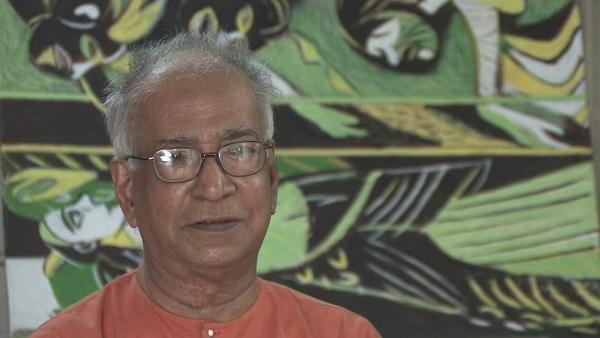NEXT STORY

Pop art and glass painting
RELATED STORIES

NEXT STORY

Pop art and glass painting
RELATED STORIES



So I started doing those polyptychs, first a three-piece then nine-piece. I used to put them together and make it, and one thing led to another, then I did a series of polyptychs which had kind of a gestural descriptive illumined in each, like what you see through a window pane in New York. Then I continued that when I came back to India, this sort of thing, and slowly they became more and more figural, and realising that in any case there was no great conflict in the whole tradition of Indian painting or sculpture between abstraction and figuration because what was figural was generally a composite abstract, and what was abstract was really, had sort of a bristling descriptive element in it sort of thing, and then certain abstract elements in especially the craft tradition where a single abstract shape which is functionally abstract, that was interpreted in terms of figuration in various ways, like the axle of a wheel or this sort of a thing, the spoke of a wheel. Sometimes it is like a creeper, sometimes it is like an animal and things of that kind. So, this over-projection of abstract elements with figuration has been there in the whole of our tradition. So it became very interesting to me, especially when I was now trying to find out sort of meeting points between craft and art and things of that kind. So after that, so when I came back, then I found that this thing remained in all those other countries I visited and especially in Cambodia. In fact, in Cambodia, and I also visited Indonesia at the same time, and Cambodia and Indonesia, you have buildings, you have temples which are much larger in size than anything in India. In fact, if you think in terms of Angkor Wat or the concept of Angkor Thom, their concepts are more complicated than anything in India. This I could see, and then similarly Borobudur Stupa, there isn’t anything like it in our Buddhist art, I mean of that magnitude or of that kind of... and then also in its execution. It’s remarkable to think that it was there one day and it is not there now. I mean that kind of an activity, because just, I think the last, I have visited Borobudur twice. When I visited the last time, somebody had, some mysterious man had blown away one of the Buddha figures from inside the bells. It’s a ridiculous thing to do. In fact, where will they find such a sort of a site? I mean such sublime art anywhere else? I mean they wouldn’t. Luckily it was only one Buddha figure. The other things were more or less intact. If any harm has come to him, it should have come from the conservators because some enthusiastic conservators are trying to clean the surface of that, those reliefs with almost like sort of a rough broom. So they were rubbing off the surface a little. It is true they were overgrown with fungus and black and white fungus, so you couldn’t sort of visualise the thing when you look at it with a naked eye. Like if you have a black and white photograph, probably you could make it, and they were trying to sort of reveal the yellowness of the old stone, but I don’t know in what condition they have left them. Anyway, what I am trying to say is that I found that there is a whole tradition of this bringing together the abstract and the descriptive together in very salutary ways and which is one thing that I have since been trying to do.
KG Subramanyan (1924-2016) was an Indian artist. A graduate of the renowned art college of Kala Bhavana in Santiniketan, Subramanyan was both a theoretician and an art historian whose writings formed the basis for the study of contemporary Indian art. His own work, which broke down the barrier between artist and artisan, was executed in a wide range of media and drew upon myth and tradition for its inspiration.
Title: Abstraction, figuration and Cambodian and Indonesian temples
Listeners: Timothy Hyman
Timothy Hyman is a graduate of Slade School of Fine Art, London, in which he has also taught. In 1980 and 1982, he was Visiting Professor in Baroda, India. Timothy Hyman has curated many significant art exhibitions and has published articles and monographs on both European and Indian artists.
Duration: 4 minutes, 48 seconds
Date story recorded: 2008
Date story went live: 10 September 2010